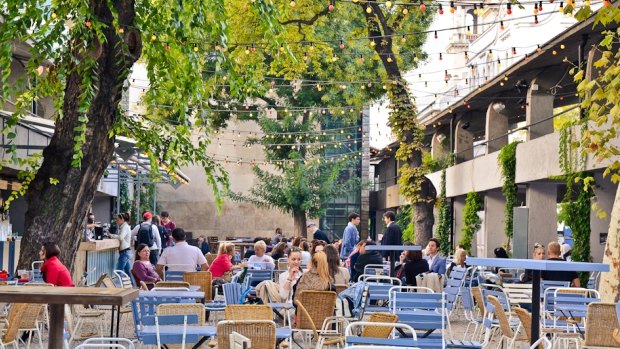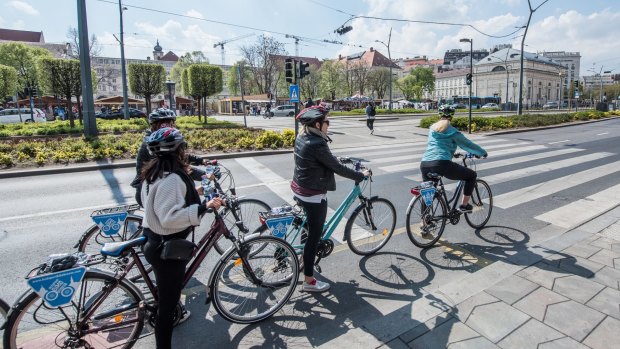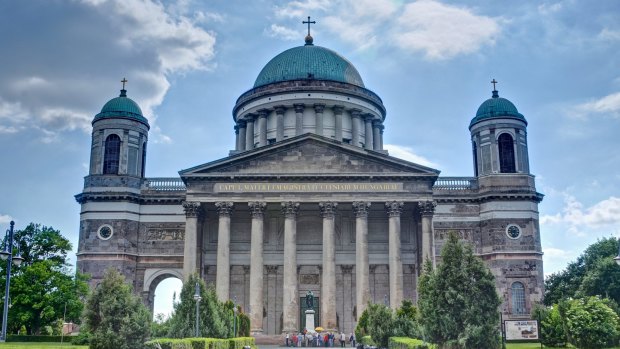This was published 4 years ago
Budapest, Hungary: Along the Danube - a bicycle tour of Europe's elegant eastern cities

Al fresco drinks at Elizabeth Square.Credit: Hungary Tourism
When it comes to cycle-friendliness, Budapest isn't quite in the same league as biking paradises Copenhagen and Amsterdam. You'll see more people walking, driving or catching the bus or tram here than pedalling about.
But with more than 200 kilometres of dedicated bike paths, some flanking the banks of the River Danube, and a flurry of bike-sharing schemes and hire shops, the Hungarian capital is a fine place to navigate from the saddle. Especially on the pancake-flat Pest side of the city, a stark contrast to Buda, the medieval district that looms on the other side of the river and has hills to make the casual cyclist weep.
We are on a biking tour prior to our Danube cruise with Avalon, and guiding us through Pest's monument-studded streets is Laszlo and Anna, whose English, like many of the Hungarians we meet, is excellent. This is most welcome as Hungarian is tricky to get to grips with. Part of the Finno-Ugric language group, it has more in common with Finnish and Estonian than the German, Slavic and Latin languages spoken in Hungary's neighbouring countries and evolved from a language used by the ancient nomadic tribes that gravitated here from the steppes of Russia.

Exploring Budapest by bike.Credit: Emil Chalhoub
We hear Hungarian chatter drifting from a flea market on Erzsebet ter (Elizabeth Square), one of Pest's focal points, a sprawling mish-mash of concrete and green space where both locals and tourists gather to drink, picnic and skateboard. We park up and listen to Anna's intriguing anecdotes about Budapest past and present. This square was renamed after Stalin, then Engels, during Hungary's post-World War II Soviet occupation, but reverted to its original title in 1990, named after Empress Elisabeth, nicknamed "Sisi", the wife of Habsburg Emperor Franz Joseph.
The area we're in now, in fact, District VII, is also known as Erzsebetvaros (Elizabeth Town). Anna tells us that Sisi, who was born in Munich, endeared herself to the people after she became Queen of Hungary. She apparently preferred staying in Budapest to Vienna, the main seat of the Habsburgs' Austro-Hungarian Empire, and even made the effort to learn Hungarian. Sisi's assassination by an Italian anarchist in Geneva, in 1898, sparked widespread mourning, but her legacy endures and just east of Elizabeth Square, a bronze sculpture of Sisi, holding a parasol and wearing a light summer dress, was unveiled last year.
Most of the landmarks we cycle past, or pull in next to, date from the century after the Great Flood of 1838, when the Danube burst its banks, flooding Pest and destroying or seriously damaging most of its buildings. Hungarian architects, many whom had worked and studied abroad, were tasked with turning Budapest into one of Europe's most elegant cities. The revamped metropolis earned the moniker the "Paris of the East" and there are certainly shades of the French capital as we pedal along wide boulevards, passing Belle Epoque hotels and civic buildings, Michelin-starred restaurants and high-end boutiques, and side streets lined with alfresco cafes and kebab shops.

St Stephen's Basilica.Credit: Hungary Tourism
There are sights in Budapest, however, that you won't find anywhere else, not least its mammoth riverside parliament building. Tomorrow night, we'll admire it, illuminated, from the top deck of our Avalon ship, but even in the light of day, gawping up at it from our bikes, it's a spectacle. A forest of spires and a huge burgundy dome jut from this neo-Gothic marvel, which is 268 metres long (one metre less than the Titanic), 118 metres wide and 96 metres tall. Symbolising the balance between church and state in Hungary, it's the same height as the almost-as-stunning neoclassical St Stephen's Basilica, which we'd seen earlier, named in honour of the first King of Hungary.
Anna says tourists often ask her why Hungary, a country of just 10 million people, has such a huge and glamorous parliament building, with its 691 rooms, 20 kilometres of stairs and lashings of gold and marble. It was completed in 1902 when Budapest had heady ambitions as a leading light of the mighty Austro-Hungarian empire. But after World War I, the empire crumbled, and Hungary lost about 70 per cent of its territory, including a chunk of Transylvania that is now in Romania but still home to almost 2 million ethnic Hungarians.
In recent years the parliament has attracted demonstrations from protesters rallying against the policies of Hungary's ruling right-wing party led by Viktor Orban, one-time anti-Communist activist and prime minister since 2010. But the biggest noise today comes from the vintage yellow trams rattling past the square edging the parliament and a hen party of young women on bikes talking and laughing as they breeze by.
It's easy to get into the spirit of things in Budapest, especially in the back streets of its old Jewish quarter, which fans out from Europe's largest synagogue, a flamboyant Moorish-style affair built in the 1850s. Part of Elizabeth Town, this neighbourhood has changed more than most in the city's post-Communist tourism boom, thanks, in large part, to its famous "ruin pubs", which we experience later, after our cycling tour.
These quirky watering holes occupy a cluster of formerly dilapidated buildings and warehouses, and have been transformed by creative entrepreneurs and festooned with eclectic art and design. While the original ruin pub, Szimpla Kert, is still going strong, other venues have capitalised on the trend and lure a diverse crowd of revellers, young and middle-aged, Hungarian and foreign.
We start in Doboz, which boasts many of the ingredients of your quintessential ruin pub. A labyrinth of rooms, spread over three levels, and playing different types of music at various decibel levels, overlook a central interior courtyard with a gaze-stealing art installation. At Doboz, a wooden sculpture of a giant clambers up a live, 300-year-old tree.
I usually try not to mix my (alcoholic) drinks, but, as we continue our ruin pub crawl, and pop into other cool places such as Extra and Fogashaz, I sample an array of Hungarian tipples – all in the name of research, of course. There's the perennially-popular Dreher lager (decent); Belgian Cherry, a fruity craft beer brewed in Budapest (not bad); palinka, a (potent) brandy schnapps that originated in the Hungarian countryside; and Budapest Mule – a strong, bitter concoction of ginger, lime and Unicum szilva, a herbal liqueur. I can't, in good conscience, recommend that to you. But the ruin pubs, on the other hand, are great: good vibes, fun to explore, full of hidden delights and, with each passing drink, the decor becomes ever more weird and wonderful.
FIVE MORE THINGS TO DO IN BUDAPEST
HIT THE SPA
Budapest has heaps of thermal springs and you can take a dip in a range of indoor and outdoor spa complexes of varying opulence.
COFFEE HOUSES
Pest has a superb selection of imperial-era coffeehouses, where you can enjoy caffeine hits and calorific cakes such as dobos torte, Budapest's answer to Vienna's sachertorte, in decadent surrounds.
CAVES
Peppered with iconic landmarks and lookouts over the Danube, the city's Buda side is riddled with caves that you can delve into. Some sport peculiar natural rock formations and stalactites; others house a military hospital and nuclear shelter.
GREAT MARKET HALL
Beneath the soaring ceiling and intricate ceramic roof tiles of this vast 1897 building, vendors sell fresh produce, souvenirs and classic Hungarian snacks such as langos, a deep-fried flatbread drizzled with grated cheese and sour cream.
MARGARET ISLAND
Pedal over to this laid-back, leafy retreat, one of Budapest's islands in the Danube. There are parks, gardens, a zoo, fountains, pools, cafes and open-air parties and concerts in summer.
TRIP NOTES
Steve McKenna was a guest of Avalon Waterways and Globus family of brands.
MORE
CRUISE
Budapest is the start and end point for a selection of Danube cruises with Avalon. A 10-day The Legendary Danube voyage, sailing between Budapest and Nuremberg, with a two-night stay in Prague, is priced from $2788 a person based on double occupancy and includes gratuities and wine with meals, plus a complimentary shore excursion in each port of call. The ship also has bikes that you can take out for rides. See avalonwaterways.com.au
FLY
Emirates and Qatar Airways has flights from Sydney and Melbourne to Budapest via Dubai and Doha respectively. Flights and pre and post-cruise accommodation can be booked in your Avalon package. See emirates.com/au; qatarairways.com
TOUR
Budapest Bike Breeze has guided city bike tours from €25 ($40). See budapestbikebreeze.com
Sign up for the Traveller Deals newsletter
Get exclusive travel deals delivered straight to your inbox. Sign up now.